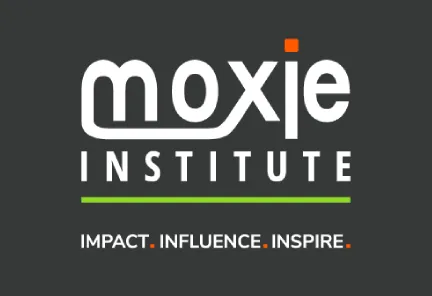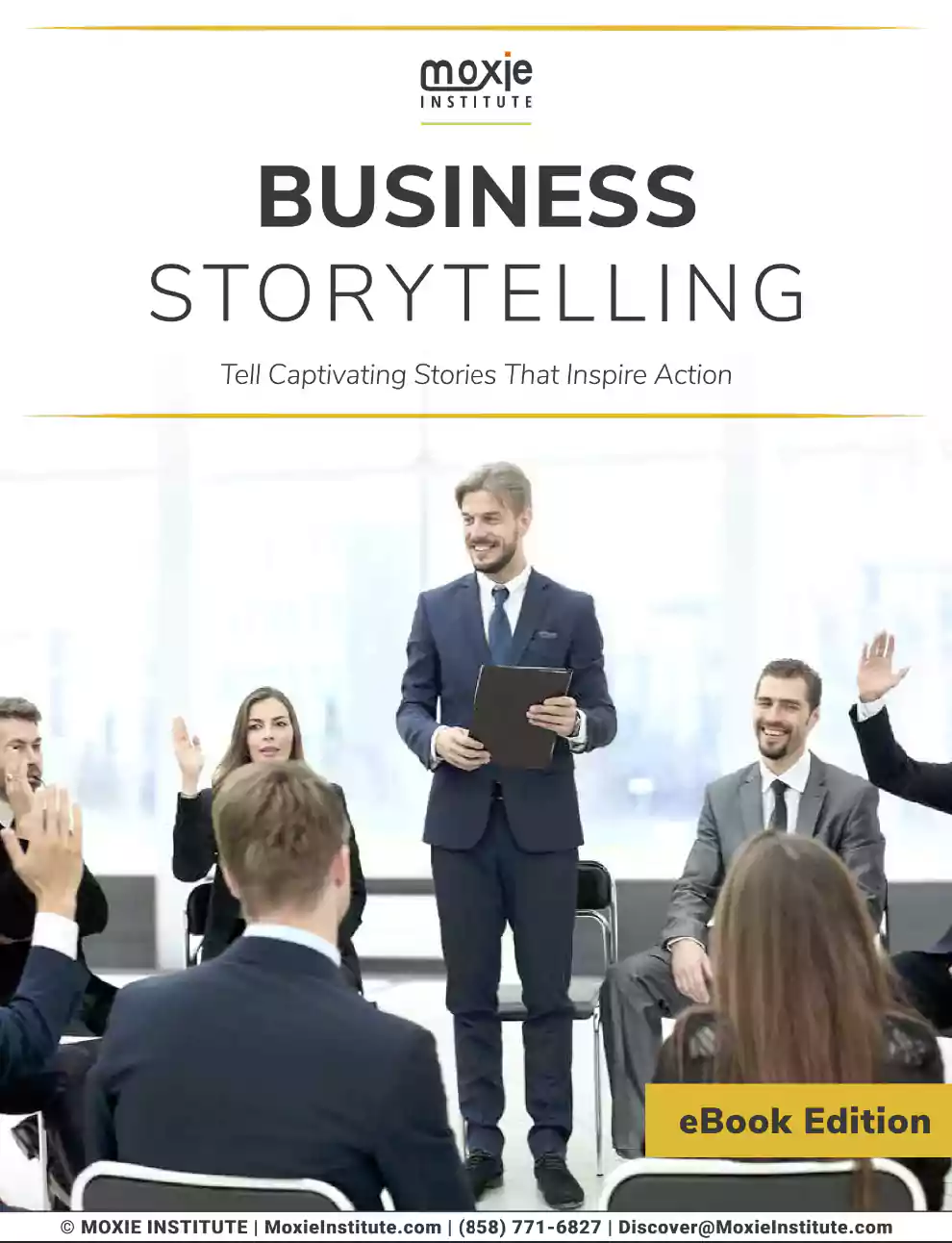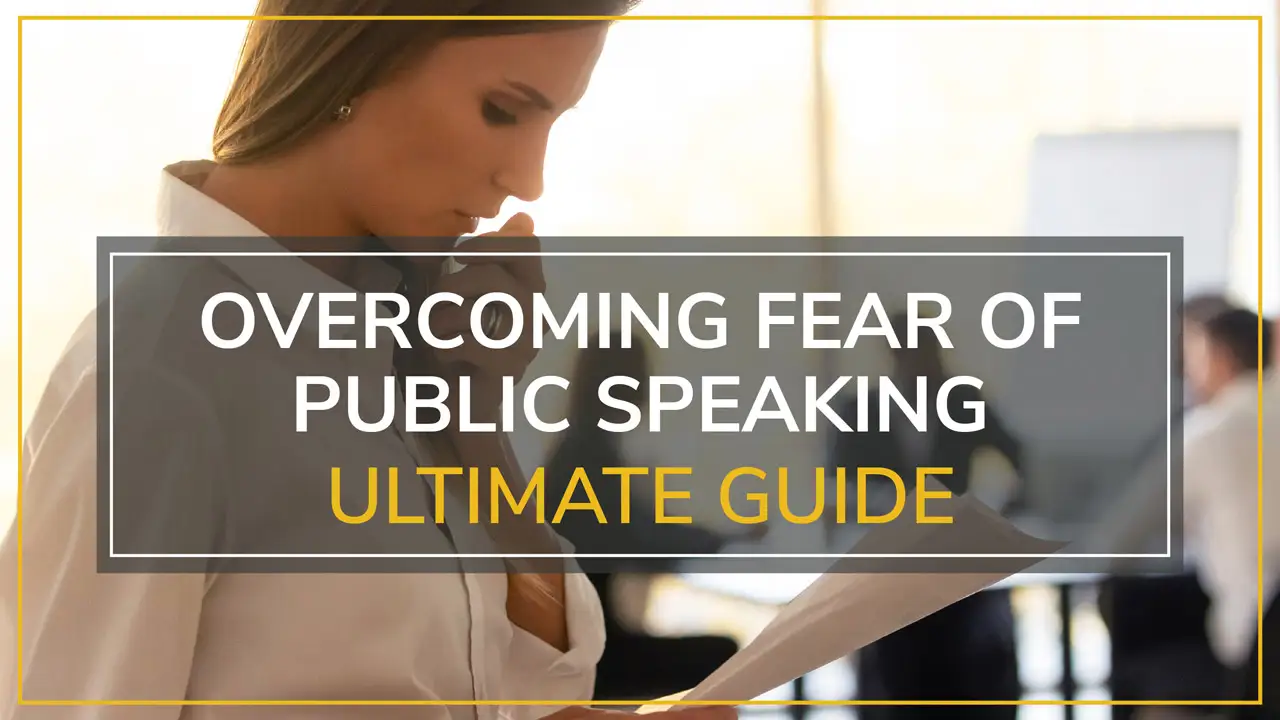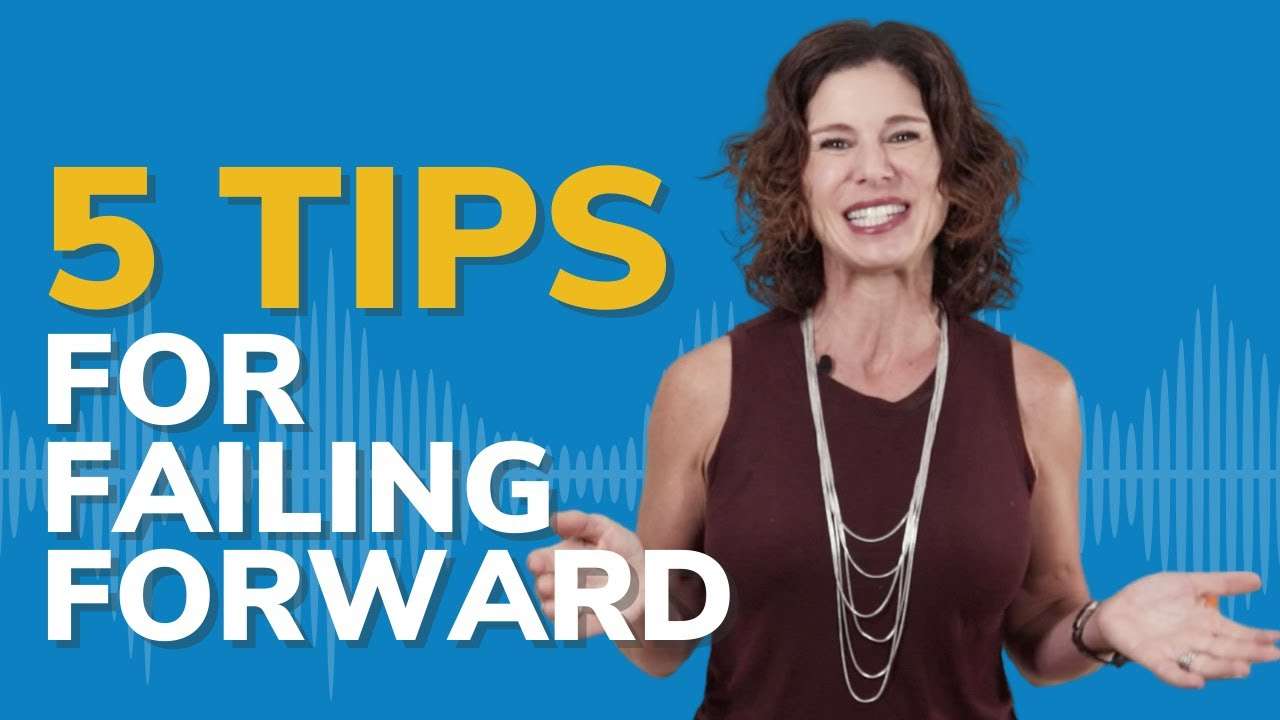Introduction
Picture this: You’re in a boardroom, explaining quarterly results to skeptical investors. The statistics are strong, but the faces are still cold as stone. Then you start: “January last year, our customer service rep, Sarah, got a call that would blow the top off everything we had ever been told about our tipping point…” All at once, every eye is upon you. Phones disappear. Note-taking stops. You just witnessed the magic of being able to tell stories.
Stories are more than mere entertainment—they are the most potent vehicle for communication in all of human experience. At Moxie Institute, we’ve had executives and professionals from practically every industry conceivable completely change the way they deliver their presentations, sales pitches, and leadership communications—all by learning the tools of storytelling training. When you begin to learn how to tell good stories, you are not just communicating data or information, you are creating an experience that is personal, compelling and that has the power to resonate and persuade action.
In our work coaching Fortune 500 executives and TED speakers, we have learned that the secret to the best presentations is not the data you present, but rather the story you convey to bring that data to life. Whether you’re giving a keynote, running a team meeting, or pitching to investors, the skill to tell a great story will elevate you far above the competition.
This principle-packed guide is the neuroscience-backed formula we’ve used to help thousands of professionals master storytelling. You will learn why stories work, you’ll learn our unique and proven IMPACT framework, and you’ll learn tools you can start using today to instantly improve the effectiveness of your communications.
The Science Behind Stories That Stick
Knowing how to tell stories well starts with knowing what goes on in the brains of your audience when they hear a good story. Neuroscience research from Princeton University describes how when we listen to a story, our brains don’t just process words—they create a shared neural experience between two people, the teller and the listener.
That phenomenon, called “neural coupling,” is why stories are orders of magnitude more memorable than facts. When someone is telling you statistics, only one part of your brain lights up—the language processing centers. But when the same someone tells a story with those stats, multiple brain regions will activate: sensory cortex, frontal cortex and even motor cortex if the story has movement.
The Neurochemical Response to Stories
Studies from UC Berkeley’s Greater Good Science Center show that good narratives provoke the release of oxytocin, which has been dubbed the “bonding hormone.” It’s this neurochemical response that creates trust and empathy between speaker and listener—which is why it’s essential for leaders who need to have an impact to understand how to tell a great story.
We’ve seen this pattern over and over in our executive coaching sessions. One tech CEO we coached could barely get a word in edgewise with his board until he was shown how to frame his vision via story. Rather than open with an analysis of the market, he started board presentations with a story of a frustrated customer whose problem his company could solve. Board engagement grew significantly and decisions about funding became much easier.
Essential Insight: Stories aren’t just for relaying information—they have the power to evoke emotional and physiological responses that can’t be achieved with facts alone. It’s for this reason that knowing storytelling strategies becomes a competitive edge in business communication.
Why Facts Tell but Stories Sell
Harvard Business Review study proves what we have found in our corporate storytelling workshops: people remember 65% of the information shared during a story, versus just 5% of information shared using statistics alone.
The difference in retention here is that stories supply context, emotion and meaning—three components our brains require to make memories stick. As you become well-versed in story dynamics that contain these ingredients, you change from information provider to experience creator.
The Universal Story Formula: IMPACT Framework
Based on studying thousands of successful presentations and speeches, we have created the IMPACT framework—a proven system for structuring stories that always keep audiences hooked. This formula applies whether you’re telling a two-minute anecdote or giving a twenty-minute keynote speech.
I – Intrigue with a Compelling Hook
Every strong story starts with a hook that is intriguing. How you start out determines whether your audience leans in or tunes out. A good hook piques curiosity, offers a surprise, or strikes an emotional chord in the first 15 seconds.
Proven Hook Techniques:
- In Media Res: Begin with action (“The boardroom fell dead silent the second I said…”)
- Unexpected Statement: Begin with a statement that is counterintuitive (“Our greatest failure became our greatest success…”)
- Sensory Scene Setting: Establish an instant sense of place (“The meeting room stank of bitter coffee and despair…”)
- Direct Address: Connect at the human level (“How many of you have ever…”)
Business Application Example: Instead of “Today I’ll talk about our Q3 performance,” try “2:47 AM last Tuesday, the phone on our customer-support desk rang with a call that would change every answer we ever gave for what we’re building.”
M – Make It Personal and Relatable
Connection happens when the story is a reflection of the audience. This does not mean revealing intimate specifics—it means spotlighting universal feelings, experiences or challenges that translate across sectors and backgrounds.
Relatability Strategies:
- Employing “we” and “us” language for inclusivity
- Reference common workplace experiences
- Showcase universal emotions (frustration, excitement, fear, hope)
- Include details and specifics that feel real
Pro Tip from Our Speech Coaches: The most relatable stories often include episodes of vulnerability or insight. Share the human side of professional lives—the anxiety before a big presentation, the exhilaration of a breakthrough, the disappointment of a setback.
We’ve had plenty of success working with sales teams, and in our experience, stories about overcoming rejection, or learning from mistakes, tend to resonate more than stories of landslide victory. Imperfect authenticity is what audiences trust in a speaker.
P – Present the Challenge or Conflict
Every compelling story needs tension. You have no tension, nor conflict, nor anything to figure out or solve, and your story is missing a dramatic arch which keeps the viewer hooked. In business storytelling, where the challenge is often a problem your audience faces, this is especially important.
Types of Business Conflicts:
- External Challenge: The market, competition, economy are the enemies
- Internal Challenge: Team group dynamics, resource limitations, lack of skills
- Personal Challenge: Conquering fear, gaining confidence, learning new skills
- Process Challenge: Our systems are not working for us
Conflict Development Framework:
- Establish what was at stake
- Demonstrate why “out of the box” solutions wouldn’t work
- Emphasize what they’re missing out on—emotionally or financially by not acting
- Generate momentum to fix things
We coached one pharmaceutical executive who totally reworked his FDA presentations by describing the work of regulatory compliance not as a bureaucratic task, but as a life-and-death challenge with real patients counting on its success. This shift in narrative focus really helped him increase his level of persuasion with regulatory authorities.
A – Action and Transformation
This part specifies how to overcome the above challenge. Action sequences in business stories have the double effect of transporting the story forward and providing tactical advice to your audience.
Action Elements That Resonate:
- Decision Points: A time when a decision had to be made
- Strategic Thought: Justification of certain ways of doing things
- Team Collaboration: How people interact in groups to find solutions
- Iterative Learning: What went wrong and what went right
- Resource Mobilization: How support was sought
Transformation Indicators:
- Attitude changes that opened new ways of thinking
- Skill development that unlocked capabilities
- Process improvements that created efficiency
- Relationship changes that improved outcomes
Implementation Insight: The most powerful sequences of moves have details in them that show expertise without overwhelming the viewers. Share that information at a level that sounds plausible, but don’t let the chronology become bogged down in technical details.
C – Climax and Resolution
The peak is that moment of highest tension—it is success or failure on the line. Your resolution needs to be both satisfying and inevitable in light of the choices that have been made.
Climax Characteristics:
- High Stakes: The importance of the outcome is clear
- Time Pressure: There’s a “this needs to get solved, yesterday” feel to it
- Uncertainty: The outcome isn’t guaranteed
- Specificity: The specifics of it make the moment feel real
Resolution Elements:
- Clear Outcome: What specifically happened
- Quantified Results: Measurable impacts when possible
- Emotional Payoff: What people felt when they learned what happened
- Broader Implications: What the success of the moment represented
Masterful Execution Technique: The best climaxes come out as a matter of course, not some miraculous save. Your audience should respond with, “Of course that’s what occurred!” and not, “That’s too good to be true.”
T – Takeaway and Call to Action
Each tale should impart a clear moral and charge your listeners with a specific action step. The learning creates a shift in your story from a point of entertainment to a point of education, and a CTA guides people on exactly what action they should take with the information received.
Effective Takeaway Formulas:
- “The lesson we learned is…”
- “What it showed us about [topic] is…”
- “If you don’t get one other thing, get this…”
- “The game-changing principle was…”
Call to Action Types:
- Behavioral: Specific actions to take
- Cognitive: Novel ways to address problems
- Relational: How should you behave differently toward others?
- Strategic: The art of planning or making a decision
Strategic Reminder: Your call to action should seem like a foregone conclusion of your story, and not an unnecessary sales pitch. The strongest CTAs spring naturally from the story journey you’ve told your audience.
Advanced Storytelling Techniques for Business Professionals
Learning to tell great stories is a skill at a very high level, and if you learn what professionals do, you’ll easily compete with most of your competition. These are principles we have created working with thousands of speakers and executives that will make your stories have their greatest effect.
The Power of Sensory Details
In fact, neuroscience research published in Scientific American demonstrates how sensory information relayed within stories stimulates the same brain regions involved when people experience something first-hand, leading to more engaging and memorable experiences. When you tell of the sound of clicking keyboards in an edgy boardroom or the smell of fresh coffee while a group is brewing brand new ideas during a dawn strategy meeting, you enable your audience to live your story rather than simply hear it.
Sensory Integration Strategies:
- Visual: Color, light, facial expression, body gestures
- Auditory: Voices, sounds, silence, music
- Kinesthetic: Textures, temperatures, physical sensations
- Olfactory: The memory-triggering and emotion-provoking scents
- Emotional: The emotion involved in the setting and interaction
Business Application: Rather than write “The conference was tense,” write “You could hear every breath in that conference room—that’s how quiet this silence was; you could hear the sound of your own heart.”
Mastering Pacing and Rhythm
Professional storytellers know that what is said is just as important as how you say it. Rhythm can convey mood, tension and even emphasize a character trait.
Pacing Techniques:
- Slow for Setup: Establish context, characters etc. at first
- Accelerate Through Action: Enliven scenes by picking up the pace during exciting or tense moments
- Pause for Impact: Tactical pauses highlight key points
- Vary Sentence Length: Short sentences lead to urgent prose, long ones offer detail
Rhythm Creation Methods:
- Rule of Three: Use threes for easy transitions among several points
- Parallel Structure: Repeat same structure of words at various points for emphasis
- Callback References: Circle back to the preceding for connection
- Escalating Intensity: Let the energy grow as the story progresses
In our storytelling workshops, we practice what we’ve named “vocal architecture”—using the rise and fall of your volume, the pace of your words and the strategic pause to build the emotional landscape of your story. This is what makes average content into great experiences.
Common Storytelling Mistakes That Kill Engagement

In fact, even seasoned experts make predictable mistakes as they learn to tell good stories. Identifying and bypassing these pitfalls can help you leverage storytelling to maximum effect.
Mistake #1: Too Much Background Context The Problem: Wasting time on scene setting demotivates the reader before the story even starts. The Solution: Start with action or dialogue and introduce necessary context as the story progresses.
Mistake #2: Vague or Generic Details The Problem: Instead of saying “we had a challenging client situation,” give specific, vivid details. The Solution: Include exact details that make the story seem real and make you feel like you are there.
Mistake #3: Multiple Competing Storylines The Problem: When you attempt to tell several stories at once, audiences get confused. The Solution: Pick one coherent narrative arc with one central conflict.
Mistake #4: Weak or Missing Takeaways The Problem: Wrapping up stories without clear lessons or takeaways. The Solution: Let the audience know clearly what they are supposed to learn or do differently.
Mistake #5: Inappropriate Story Length The Problem: Stories that are too lengthy given the context or the attention span of an audience. The Solution: Match story length to speaking time: 30-second stories for small points and 3-to-5-minute stories for big ideas.
Mistake #6: Lack of Emotional Connection The Problem: Sticking to facts and events without exposing feelings or intentions. The Solution: Explain how people felt at pivotal moments, and why those feelings mattered.
Recovery Strategy: If you feel like the audience is starting to lose interest in a story, use some of these techniques:
- Add more eye contact and vocal variety
- Introduce the reader to an interesting fact or new twist
- Pose a rhetorical question that moves the conversation forward
- Use the power of the strategic pause to make people curious and build suspense
Practice Exercises: Develop Your Storytelling Skills
Storytelling is a learned skill, like anything else. These exercises, created as we’ve taught thousands of people, will bring your storytelling abilities online in a big way, step by step, day by day.
Exercise 1: The Two-Minute Challenge
Objective: Learn how to write full, entertaining stories in not a lot of time.
Instructions:
- Pick a major professional moment from the last year
- Name the main conflict or problem
- Use the IMPACT framework to structure your story
- Try and say it in 2 minutes
- Record yourself and watch for clarity, engagement, and takeaway potency
Success Metrics:
- Story starts, builds up, and comes to a good end
- Includes specific, sensory details
- Provides actionable takeaway
- Feels complete within time limit
Exercise 2: Sensory Story Expansion
Objective: Learn to write vivid descriptions and create scenes that bring you into other worlds.
Instructions:
- Start with a simple work story (“We had a hard team meeting”)
- Include one sense detail from each category: Hearing, Sight, Smell, Taste, Touch
- Add some emotion for your key players
- Keep practicing the longer versions until it feels natural to you
- Try it out with a coworker and check engagement gains
Before: “We had a challenging team meeting about budget cuts.” After: “Stepping into that conference room was like stepping into a funeral parlor—you could smell the same old tension in the air, mixed with some kind of burnt coffee, and Janet’s normal smile had been replaced by the kind of tight-lipped look that said way too much without really saying anything.”
Exercise 3: Industry Translation Practice
Objective: Show how to cater stories to different readerships and situations.
Instructions:
- Create one main story on professional development or learning
- Create three versions tailored for:
- Top management (focus on strategic consequences)
- Middle management (emphasize team leadership)
- Individual contributors (highlight skill development)
- Practice transitioning between versions smoothly
- Identify what is fixed and what varies
Adaptation Focus Areas:
- Vocabulary and technical language level
- Timeframe and scope of implications
- Decision-making responsibilities highlighted
- Metrics and outcomes emphasized
Your Storytelling Implementation Roadmap

Changing the way you communicate with better storytelling takes practice and a process. Drawing on our work with executive coaching clients, this roadmap offers a structured approach to scaling your storytelling skills.
Phase 1: Foundation Building (Weeks 1-2)
Week 1: Story Inventory
- Document 10-15 significant professional experiences
- Give the central conflict in each case
- Jot down any possible lessons from each experience
- Practice nailing the exact details of each story with just one sentence
Week 2: Framework Mastery
- Apply the IMPACT framework to your top 5 stories
- Focus on creating compelling hooks for each narrative
- Develop clear, actionable takeaways
- Practice delivering each story to the mirror
Phase 2: Skill Development (Weeks 3-6)
Week 3: Sensory Enhancement
- Inject color into your core stories
- Try to describe places, feelings, sensations, physical things
- Focus on making your stories something that audiences feel, not just hear
Week 4: Pacing and Rhythm
- Experiment with different delivery speeds
- Practice strategic pauses for emphasis
- Work to put variety in your voice and keep it from getting monotonous
Week 5: Audience Adaptation
- Rehearse the same story for various potential listeners
- Modify complexity, vocabulary, etc., to match listener needs
- Create formal and informal variations
Week 6: Integration Practice
- Insert narratives into real work conversations
- Use stories in meetings to illustrate concepts
- Train yourself to move smoothly from storytelling to analysis
Phase 3: Advanced Application (Weeks 7-8)
Week 7: Spontaneous Storytelling
- Try to make up stories on the fly out of recent personal experiences
- Learn to structure quickly under pressure
- Be conscious to align with the IMPACT framework even within casual talk
Week 8: Feedback Integration
- Record yourself telling stories and judge objectively
- Ask for input from peers or mentors you respect
- Refine based on audience reaction and level of engagement
Ongoing Development Strategies:
- Maintain a story journal to record experiences as they happen
- Learn from storytellers who are masters in your company, industry or area of expertise
- Participate in speaking groups like Toastmasters and practice regularly
- Look for opportunities to speak to diverse groups
How Different Industries Use Strategic Storytelling
The art of telling stories differs depending on the industry and professional setting. Our experience with clients across industries has uncovered sector-specific use cases and best practices.
Technology and Innovation
Stories from tech leaders help to put a little flesh on the literal bones of complex technologies and abstract concepts. Data storytelling becomes extra important when explaining to non-technical audiences.
Common Story Types:
- User story tales to illustrate product value
- The innovation back-story behind development decisions
- Real world implementation case studies
- Vision stories that illustrate technological possibilities
Example Framework: “Sarah is a marketing manager with no time to spare. She used to spend 3 hours every morning putting together social media reports. This is how our analytical engine changed her day…”
Healthcare and Life Sciences
Stories are tools that healthcare professionals use to explain complicated medical topics, illustrate what the outcome of treatment looks like, and develop empathy for what patients go through. Regulatory slides need stories for relating study data to human beings.
Effective Approaches:
- Patient journey stories (anonymized) that demonstrate success of treatment
- Medical breakthrough narratives with time from research to application
- Challenge narratives against the backdrop of regulatory or developmental hurdles
- Team collaboration stories showing the impact of multidisciplinary working
Financial Services
Financial professionals use stories to help turn nebulous ideas into concrete ones, and to create faith in managing funds. Understanding complex financial strategies is made easier for customers with risk scenarios and success case studies.
Story Applications:
- Client success stories showing how well their investment strategy works
- Risk management scenarios making clients aware of potential challenges
- Market trend stories following real economic concepts by example
- Planning narratives that reflect long-game financial strategies
Sales and Business Development
Sales communication training heavily emphasizes storytelling because nothing builds trust, overcomes objections or shows the value of your offering like a good story.
High-Impact Story Categories:
- Origin stories that tell people why your company even exists
- Customer transformation narratives showing before-and-after results
- Challenge-resolution stories responding to objections
- Vision stories that help the prospect visualize future success
Advanced Sales Insight: The best sales stories make the prospect the hero of their own success story and cast your product as the solution that facilitates victory.
Frequently Asked Questions
What’s the ideal length for business stories?
The best story length is relative to the situation and intent. Seek out the 30-90 second range for short bursts in presentations. For serious keynote stories, 3-5 minutes can be effective. In our executive coaching experience, the most impactful business stories can be delivered end to end within 2-3 minutes using the IMPACT framework.
Research conducted by the Journal of Business Communication found that audiences tune in with interest and it peaks after about 90 seconds of story, making this the sweet spot for most business applications. Yet if yours is the story that is the star of the show, then yes, people will engage with a longer tale, as long as it has consistent tension and progression all the way through.
How can I make my stories more memorable?
Powerful narratives merge emotional resonance with a focus on the specific and sensory. The neuroscience is clear: Our brains retain experiences that engage multiple sensory systems and our emotions. Include anything people saw, heard, felt and/or experienced emotionally in pivotal moments.
According to our training of Fortune 500 executives, the most memorable business stories include:
- Dialogue that gives us more insight into characters’ complex personalities and motives
- Little things that bring the scene to life
- Feelings to which audiences can all connect personally
- Observable change, visible clear transformation
- Insights that are applicable to your audience
The trick is to strike a balance between specificity and relatability—giving your story enough detail to feel real, but also making it universal enough that people of different backgrounds can see themselves reflected in your narrative.
Should I include failures or mistakes in my business stories?
Absolutely. Tales about struggles overcome, lessons learned, or recovering from failure often form stronger bonds than pure success stories. Harvard Business Review studies show that when leaders publicly share personal struggles they gain more trust and credibility.
The trick is not to dwell on failure as a negative but to frame it as an opportunity to learn. Focus on:
- What you took away from the experience
- The challenge that prompted better methods
- The growth that flowed from overcoming obstacles
- How these lessons apply to current times
In our corporate storytelling training, we talk about the “vulnerability sweet spot”—sharing enough that authenticity can be felt but not so much that it undercuts your credibility or authority.
How can I practice storytelling without formal speaking opportunities?
Good storytelling is a skill that requires practice in low-stakes situations to develop. Here are some ways to develop your powers:
Daily Practice Opportunities:
- Team meetings: Elaborate on concepts or provide context with short stories
- Individual conversations: Trade experiences to get to know and establish close relationships with others
- Email: Incorporate anecdotes to make your point
- Social situations: Apply storytelling tactics in everyday discussion
Structured Practice Methods:
- Record your stories and see where you can enhance them
- Get involved in organizations such as Toastmasters that give you a platform to speak regularly
- Practice with family or friends who can give you honest feedback
- Record videos to tell professional stories on LinkedIn
Internal Rehearsal Techniques:
- Mental narrating on commutes or during exercise
- Journaling stories out to plot structure and details
- Preparing story sketches for future presentation use
- Analyzing great storytellers in your niche for technique ideas
What’s the difference between storytelling and case studies?
Stories and case studies are both narrative-based ways of communicating information, but they are best understood as having distinct purposes and operating in different ways. Case studies primarily emphasize analytical conclusions and achieved outcomes, while stories focus on emotional connection and hands-on learning.
Case Study Characteristics:
- Objective, data-driven presentation
- Systematic problem-solution-results format
- Multiple perspectives and quantified outcomes
- Comprehensive analysis of contributing factors
Story Characteristics:
- Subjective, experience-driven presentation
- Dramatic arc with tension and release
- Single perspective with emotional resonance
- Focus on transformation and self-discovery
At the business level, the best solutions tend to be some combination of the two: use storytelling tactics to enliven case studies, or include case-study data to buttress the credibility of stories. Our clients are reporting that “storified case studies” is an approach that combines both emotional engagement and analytical rigor.
How do I handle stories when cultural differences might affect audience understanding?
When creating your narratives, cultural sensitivity means that you must understand your intended audience but maintain the authenticity of the story. The key is to choose universal human experiences while being sensitive to cultural references, humor, and assumptions.
Universal Story Elements That Transcend Culture:
- Professional challenges and growth experiences
- Team collaboration and relationship dynamics
- Problem-solving and innovation processes
- Learning from mistakes and adaptability to change
Cultural Considerations:
- Don’t use idioms, colloquialisms or culture-specific references
- Pick examples with universal applicability in different business settings
- Be aware of hierarchy and authority issues from other cultures
- Focus on work experience, not personal experience
Adaptation Strategies:
- Share stories with colleagues from other cultures
- Write a few versions of important stories for different types of viewers
- Emphasize the lessons learned rather than the specifics
- Use inclusive language without relying on presumptions of shared cultural knowledge
Can storytelling work in highly technical or data-driven presentations?
Data storytelling training has become a necessary skill because people forget dry, technical details unless they are part of a story that pulls them in emotionally. The most successful technical talks use narratives to set the stage, describe significance, and illustrate use cases.
Technical Storytelling Strategies:
- Demonstrate technical solutions to actual problems through customer use cases
- Frame data analyses in decision narratives
- Share discovery anecdotes of how technical insights were revealed
- Add tales of implementation to demonstrate technical solutions in practice
Balance Techniques:
- Beginning with story, present data, and end with story implications
- Use stories to segue between technical material
- Include little stories to put a human face on difficult technical concepts
- Frame technical victories in the form of journey stories with roadblocks and breakthroughs
This doesn’t mean replacing your technical information with stories, but rather embedding your technical information within narrative context so that it is more helpful than ever for your audience to act on.
How do I know if my storytelling is improving?
Assessing progress in storytelling is a matter of both subjective response and empirical evidence. Assess yourself through the following methods:
Audience Engagement Indicators:
- Increased eye contact and attention during stories
- More questions and comments after the narrative passages
- Positive reaction that makes reference to your examples or stories
- Requests to repeat or elaborate on specific narratives
Professional Impact Measures:
- Improved presentation effectiveness ratings
- Increased success in meetings and more convincing presentations
- Enhanced capability of explaining complicated concepts
- Stronger relationships and communication with coworkers and clients
Self-Assessment Techniques:
- Record presentations to assess story delivery and structure
- Time the stories to make sure they are appropriate for the context
- Consider if stories have intended effects (explanation, persuasion, empathy)
- Track comfort level and confidence when telling stories
Skill Development Milestones:
- Ability to develop interesting stories on the spot
- Seamless narrative integration within all kinds of communication
- Stories tailored to a variety of audiences without sacrificing their essential force
- Others’ acknowledgement of being a great storyteller and communicator
TAKE THE FIRST STEP TO MASTER POWERFUL NEW SKILLS
Schedule an easy 30-minute call using our using our calendar. We’re here to help!









